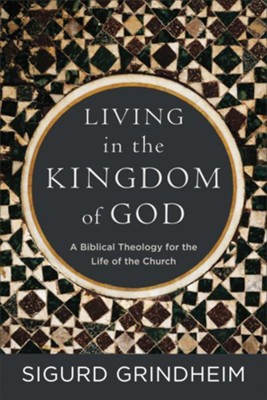Sigurd Grindheim
Grand Rapids: Baker Academic, 2018. 192 pages. Softcover. $24.99

Reviewed by E. Anthony Sikora on 09/18/2019
As the reader will note, there is no shortage of published material regarding the “kingdom of God.” One can easily find piles of books on the topic with each author highlighting a particular aspect of the kingdom of God using a plethora of Bible passages to support their premise. In many ways, Grindheim’s book “Living in the Kingdom of God: A Biblical Theology for the Life of the Church” is no different. Refreshingly, however, Grindheim does not go the way of many of his contemporaries which often misuse the term, and therefore much of the Bible, in order to awaken their readers to today’s social injustices. No, Grindheim, in a seemingly chiastic fashion, sets the Gospel of Jesus Christ and the free forgiveness of sins squarely in the center of his thesis and therefore also in the center of this book.
Each chapter in the book has its counterpart. Chapter one discusses our “dream of utopia” and humanity’s failure to attain it due to our first parents fall into sin. Chapter eight concludes the book looking forward to the day of Christ’s return and the perfect manifestation of the Kingdom of God in the new heavens and the new earth.
Chapter two sets forth the biblical answer to humanity’s failure in the coming of Jesus as the King who rightly deals with the root problem of evil in the world: sin, death, and the devil. “Where Jesus is, there God rules. When you see the person of Jesus Christ, then you see God’s rule on earth. Where Jesus is, there the world is the way God wants it to be. Evil must flee. Justice is established. There is life. There is blessedness. Everything is good. God’s rule is there” (25). In chapter seven Grindheim shows how the Christian community, Christ’s Church, engages society and carries the kingdom of God to the far reaches of the globe. As hearts are transformed by the gospel, whole communities are changed.
In chapter three Grindheim contrasts Jesus’ kingly nature with that of humanity’s expectations. Jesus is a different kind of king who brings a different kind of rule. “He exercised His might by suffering, by being humiliated, and by appearing to suffer the ultimate defeat: the shameful death of crucifixion . . . ” (pg.46). Having defeated evil, Jesus sets the captives free. That freedom is expressed in chapter 6 as Grindheim discusses the freedom of the Christian, freedom to live as His own dear children. This freedom is a freedom to be good. “No one can do good works unless they are free” (117). The kingdom of God is a kingdom ruled by a gracious king. This “kingly rule of God is a reality that is hidden under the guise of weakness,” (119) not in power or glory.
Chapters four and five are the center of the book. Everything leads to these chapters and everything flows from them. Chapter four sets forth how a person enters the kingdom. Chapter five describes what the kingdom looks like. In chapter four one enters the kingdom by grace through faith. In chapter five we find Christians exercising Christ’s kingly rule as they receive and show forgiveness, are reconciled to God in Christ and reconcile with others. This kingly rule is not established by Christians, nor the church, but it is proclaimed.
Throughout his work, Grindheim makes of use of the biblical testimony, drawing his conclusions from the text rather than the current zeitgeist. This makes for a compelling read and a welcome addition to the many and various writings on the Kingdom of God.



